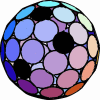Origin of icosahedral symmetry in viruses
- PMID: 15486087
- PMCID: PMC524849
- DOI: 10.1073/pnas.0405844101
Origin of icosahedral symmetry in viruses
Abstract
With few exceptions, the shells (capsids) of sphere-like viruses have the symmetry of an icosahedron and are composed of coat proteins (subunits) assembled in special motifs, the T-number structures. Although the synthesis of artificial protein cages is a rapidly developing area of materials science, the design criteria for self-assembled shells that can reproduce the remarkable properties of viral capsids are only beginning to be understood. We present here a minimal model for equilibrium capsid structure, introducing an explicit interaction between protein multimers (capsomers). Using Monte Carlo simulation we show that the model reproduces the main structures of viruses in vivo (T-number icosahedra) and important nonicosahedral structures (with octahedral and cubic symmetry) observed in vitro. Our model can also predict capsid strength and shed light on genome release mechanisms.
Figures






Comment in
-
Viruses and the physics of soft condensed matter.Proc Natl Acad Sci U S A. 2004 Nov 2;101(44):15549-50. doi: 10.1073/pnas.0406935101. Epub 2004 Oct 25. Proc Natl Acad Sci U S A. 2004. PMID: 15505200 Free PMC article. No abstract available.
References
-
- Harrison, S. C. (1990) in Fields Virology, eds. Fields, B. N., Howley, P. M., Griffin, D. E., Lamb, R. A., Martin, M. A., Roizman, B., Straus, S. E. & Knipe, D. M. (Raven, New York), Vol. 2, pp. 37-61.
-
- Johnson, J. E. & Speir, J. A. (1997) J. Mol. Biol. 269, 665-675. - PubMed
-
- Fox, J. M., Wang, G., Speir, J. A., Olson, N. H., Johnson, J. E., Baker, T. S. & Young, M. J. (1998) Virology 244, 212-218. - PubMed
-
- Caspar, D. L. D. & Klug, A. (1962) Q. Biol. 27, 1-24. - PubMed
-
- Liddington, R. C., Yan, Y., Moulai, J., Sahli, R., Benjamin, T. L. & Harrison, S. C. (1991) Nature 354, 278-284. - PubMed
Publication types
MeSH terms
LinkOut - more resources
Full Text Sources
Other Literature Sources

